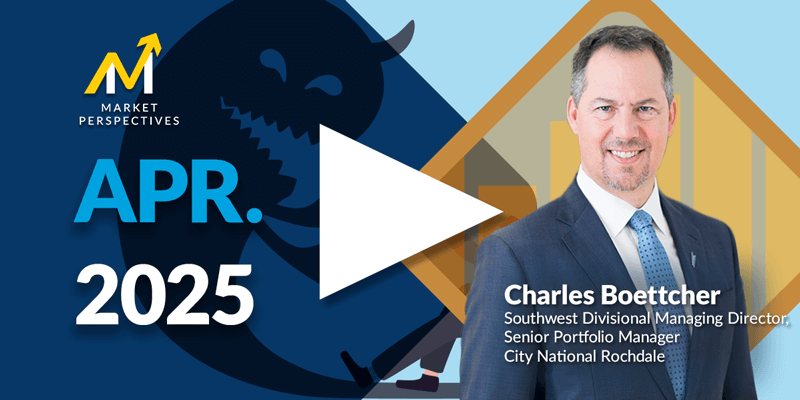
CNR Speedometers®
April 2025
Forward-Looking Six to Nine Months
TRANSCRIPT
The landscape for investors changed meaningfully this past week. The Trump Administration's broad tariff announcement caught markets off guard, not because tariffs weren't expected, but because of the magnitude and scope. The result has been a sharp repricing across global assets. The move has been broad, with virtually all sectors and global regions participating. The good news is that a quick decline of this nature, going back to 1987, has been followed by positive returns over one-, three-, and five-year time horizons.
Further, despite the scope of the decline, broader economic activity is positive. And while the data we have only accounts for the first three months of the year, it still indicates a starting point of economic strength. One of the most important indicators of market stress is the credit market, and the cost of credit has increased, but it's not pricing at levels associated with high recession risk.
Much of the focus has been on U.S. Treasurys, which have been volatile, and speculation has picked up about the source of pressure that created a large jump in yields, even as equity markets continue to move lower. Our view is that it's likely that some leveraged trades involving Treasurys as collateral were unwound, which put pressure on the market and created forced selling. Rumors regarding hedge fund liquidations and Chinese Treasury sales remain unconfirmed, but the pressure on the bond market has increased.
Our view for over a year has been that the market is now in a structurally higher rate environment, and we do not expect to see the 10-year Treasury below 4%. Combined with the potential outcome on prices from tariffs, rates will remain elevated. It's important to have context. Yields remain much lower than where they started the year, and bond market volatility has been elevated over the entire post-pandemic cycle, so it's too early to jump to conclusions about a negative shock to the structure of the bond market. Overall, we believe investors are reacting to a policy shock, not a breakdown in the economy's financial plumbing.
At CNR, we've reassessed our base case in light of the tariff developments. We are revising our expectations for growth and corporate profits down and revising our inflation forecast higher. U.S. GDP expectations have been reduced from 2%-2.5% to 0.75%-1.25%.
Corporate profit growth has been revised down from 10%-14% to 6%-8%. And inflation expectations have increased to 3%-3.75%, up from prior estimates. This, of course, is based on the tariffs remaining in place. The current 90-day pause in reciprocal levies is a positive development. And if a large proportion of the potential tariffs were dialed back, we would expect to see a more consistent market rally, and our forecast would likely improve. Despite the current policy pause, the probability of a recession has increased, but we believe the economy has some room to absorb the impact. This capacity will be exhausted if the trade war continues indefinitely.
For now, we think the Fed is likely to stay on the sidelines, especially with inflation trending above target and the labor market still showing signs of strength. A Fed rescue is not likely in the near term. Now this pullback may feel sudden, but from our perspective, it's a repricing of risk, not a collapse. Investors are digesting what these tariffs mean for supply chains, costs, demand, and ultimately, earnings.
This is an external shock, not an internal failure, and that makes a difference. As we told clients in recent updates, these kinds of moments are where portfolios are tested, but also where portfolios can adjust to best position investors for long-term return.
Given the tariff surprise, we've made changes to eight of our CNR Speedometers®. As a reminder, these dials are not market calls. They reflect the underlying macro and business environment. And while we are downgrading several indicators from green to yellow, we do not believe this undermines the potential long-term opportunity if we become more confident in a market bottom.
In fact, markets tend to price in economic shocks faster than the data can reflect them. That's why evaluating technicals is just as important as valuation and fundamentals. In many cases, large market pullbacks create more compelling future return potential, not less.
So, here's how we're seeing the landscape evolve.

■ Previous Month ■ Current Month
Monetary Policy
What we see
Monetary policy is one of two ways the government can influence the economy and financial markets. By manipulating interest rates, the Federal Reserve can raise or lower the cost of money to stabilize or stimulate the economy.
Dial 1: Monetary Policy, 4:25— We'll start with Monetary Policy — we believe the Fed is now in a holding pattern. While the market is pricing in about three rate cuts this year, we are holding steady with our call for one to two. Prices will rise based on the level of tariffs, and while the labor market will be impacted, it's not deteriorating fast enough at this point to prompt the Fed to act. And Powell's latest remarks were clear. The Fed is watching inflation risks tied to tariffs, and those risks could last beyond a short time horizon.
This means the Fed will want to see more clarity on inflation or acute labor market weakness before acting, neither of which are present at this time. We think further easing expectations are premature.

■ Previous Month ■ Current Month
US Economic Outlook
What we see
City National Rochdale utilizes a comprehensive internal research effort that is complemented by an extensive set of external research from some of Wall Street's leading strategists. This approach allows us to develop a complete and dependable forecast of economic conditions. Our economic outlook indicator provides our forecasted expectation for how well the U.S. economy will perform over the next 3-6 months.
Dial 2: U.S. Economic Outlook, 5:04— We're also making changes to our U.S. Economic Outlook. We've taken our GDP expectations down to 0.75%-1.25%, and the reason is straightforward: Tariffs represent a tax on the economy. Boston Fed research suggests that each 10% tariff on Chinese imports shaves off about 0.1% of GDP. When you add the tariffs on Canada and Mexico and consider the scope of reciprocal actions, the growth drag adds up. There's still resiliency in the economy, but it's not unlimited. If tariffs stay in place beyond the second quarter without a resolution, the drag will deepen.

■ Previous Month ■ Current Month
Business Outlook Spending/Surveys
What we see
Surveys of the business community on current and expected trends. This is a gauge on businesses' spending plans that provides an insight into wages, inflation, and capital equipment spending.
Dials 3 & 4: Business Outlook Spending/Surveys & Consumer Sentiment, 5:39— Consumer and Business Sentiment is also adjusting quickly. Sentiment has been weakening, and this will likely continue. Business sentiment is softening across regional Fed surveys, and CEO confidence has dropped notably. Capital expenditure expectations have also moved lower.

■ Previous Month ■ Current Month
Consumer Sentiment
What we see
How consumers feel about their overall financial health as well as that of the economy on the short and long term. This is an important indicator, as the consumer is the largest driver of the U.S. economy.
On the consumer side, both the University of Michigan and conference board surveys show growing concern. University of Michigan's long-term inflation expectations jumped 0.6% to 4.1%, and short-term expectations rose to 5%. That matters because consumer psychology is critical in a consumption-driven economy.
Markets have risen during periods of low sentiment, but we are concerned about the scope of the behavioral change today's levels imply. And right now, consumers and businesses are growing uncomfortable with the current trajectory of the Trump Administration.

■ Previous Month ■ Current Month
Consumer Spending
What we see
Aggregate level of consumer spending. Since consumers are the largest driver of the U.S. economy, their spending patterns have a large impact on overall economic activity.
Dial 5: Consumer Sending, 6:28— We're also seeing changes in Consumer Spending; it was the backbone of growth in 2024, but it started 2025 on a noticeably softer footing. After a strong fourth quarter where inflation-adjusted consumption grew at 4.2% annualized and contributed more than 85% of total GDP, momentum has cooled.
Real personal spending declined by 0.6% in January and showed only a modest 0.1% gain in February. The Atlanta Fed's GDP Now estimate for Q1 consumption currently stands at just 0.3% annualized. What's notable, though, is that this isn't being driven by a lack of income. In fact, real disposable income grew in both months, up 0.1% in January and 0.3% in February. So that tells us that consumers have the capacity to spend, they're just choosing not to.
Now there are a few reasons for this shift. Some may have pulled forward purchases into Q4 to get ahead of the expected tariff implementation, but there is a growing sense that uncertainty is weighing on consumer behavior. Sentiment surveys have softened, and with inflation concerns rising and news of trade tensions dominating headlines, caution is clearly rising.
If prolonged, this could put pressure on the economy. So, for now, we've downgraded this dial to reflect a more skeptical consumer, one that still has the means to buy but needs clarity to return to prior levels of spending.

■ Previous Month ■ Current Month
Labor Market
What we see
Research has shown that employment and income expectations, along with credit availability, are the most important determinants of consumer spending. Personal consumption amounts to roughly 70% of GDP, making a strong labor market essential to a healthy economy.
Dial 6: Labor Market, 7:48— The Labor Market is also adjusting. In March, the economy added 228,000 jobs, surpassing expectations and indicating underlying strength. However, the unemployment rate edged up slightly to 4.2%, reflecting more individuals entering the workforce.
Notably, sectors like healthcare and transportation continued to exhibit robust hiring. Offsetting some of the strength, the Department of Government Efficiency, or DOGE, has initiated substantial reductions in the federal workforce.
In March alone, over 216,000 government positions were eliminated, contributing to a 205% surge in announced job cuts, the third highest monthly total on record. These cuts are part of a broader strategy to streamline government operations but have raised questions about potential ripple effects.
While the federal workforce constitutes a small percentage of total employment, such significant reductions can have broader implications. Each federal job cut can lead to additional losses in the private sector, particularly among contractors and service providers reliant on government projects.
Moreover, regions with a high concentration of federal employees may experience more pronounced economic impacts.
And businesses are also exhibiting caution. The uncertainty surrounding trade policies and government spending is prompting some employers to delay hiring decisions. This hesitancy could translate into a slowdown in job creation in the coming months.

■ Previous Month ■ Current Month
Corporate Profit Growth
What we see
Corporate earnings have a significant influence on the stock market as they ultimately drive stock prices. The value of securities is the present value of all future cash flows. Companies either reinvest earnings or pay them out to shareholders as dividends, which directly impact the stock price.
Dial 7: Corporate Profit Growth, 9:10— We're also seeing some changes in Corporate Profit Growth. We're revising our earnings forecast down from 10%-14% to 6%-8%. Margins are under pressure from rising input costs and slower top-line growth. Companies are beginning to pull back on hiring and capital investment. Notably, this is not isolated to a few sectors. Earnings expectations have fallen across nearly all industries.
Q1 2025 earnings season will be in full swing soon, and corporate commentary around tariffs will be critical in assessing the economy.

■ Previous Month ■ Current Month
Inflation
What we see
While a slow, persistent rise in prices is consistent with a healthy, growing economy, a rapid increase in inflation, especially if unanticipated, can be harmful. Inflation means higher consumer prices, which often slows sales and reduces profits. Higher prices often lead to higher interest rates.
Dial 8: Inflation, 9:40— And now to Inflation — Our updated forecast, which includes tariff pass-through, expects PCE core inflation to peak above 3.5% this year. Rising input costs, longer supply chains, and tighter goods inventories are all pushing prices higher.
Corporations and consumers will bear much of the burden, but adjustments will occur, and it's important to remember that tariffs do not translate to inflation in a zero-sum gain.

■ Previous Month ■ Current Month
Equity Market Valuation
What we see
We believe that equity market valuation should be measured against both the value of stocks at their historical levels and the other investment options available. A stock is worth its future earnings, but that involves a degree of uncertainty, which affects its price depending on the degree.
Dial 9: Equity Market Valuation, 10:05— Last, we thought deeply about making an adjustment to our Equity Valuation Speedometer®. The S&P 500 price-to-earnings ratio has dropped from 21 to 19.5, reflecting lower equity prices.
Given the volatility of the situation, we decided to leave the Speedometer® unadjusted for this month but have it on watch for May. If the market were to fall to an 18 PEU or below, we would move the valuation dial higher, reflecting more attractive prices and a better potential entry point.
So, we understand this environment may feel unsettling, but we want to reiterate that this is not a financial system issue. Indicators of a systemic threat are not present, which is why we believe this is primarily a repricing of risk based on external policy. The market reaction has been meaningful but also relatively measured.
Volatility is up, but safe haven assets like Treasurys and gold haven't spiked dramatically. The key question now is when the market will have repriced enough. Historically, corrections of this magnitude have created attractive forward return opportunities. And while we don't yet have clarity on trade policy outcomes, we are watching closely for signs of stabilization.
It is important to consider the drop in the market as a reflection of these Speedometer® changes. And at some point, the risk to the outlook will be fully realized, which will create an opportunity. Potentially, an increase in equity exposure could occur before speedometer upgrades take place. As your advisors, our role is to help you navigate moments like these, not just with data and insight, but with composure. We're actively evaluating rebalancing opportunities, tax loss harvesting strategies, and long-term positioning.
Important Information
The information presented does not involve the rendering of personalized investment, financial, legal or tax advice. This presentation is not an offer to buy or sell, or a solicitation of any offer to buy or sell any of the securities mentioned herein.
Certain statements contained herein may constitute projections, forecasts and other forward-looking statements, which do not reflect actual results and are based primarily upon a hypothetical set of assumptions applied to certain historical financial information. Certain information has been provided by third-party sources and, although believed to be reliable, it has not been independently verified and its accuracy or completeness cannot be guaranteed.
Any opinions, projections, forecasts, and forward-looking statements presented herein are valid as of the date of this document and are subject to change.
CNR Speedometers® are indicators that reflect forecasts of a 6-to-9-month time horizon. The colors of each indicator, as well as the direction of the arrows represent our positive/negative/neutral view for each indicator. Thus, arrows directed towards the (+) sign represents a positive view which in turn makes it green. Arrows directed towards the (-) sign represents a negative view which in turn makes it red. Arrows that land in the middle of the indicator, in line with the (0), represents a neutral view which in turn makes it yellow. All of these indicators combined affect City National Rochdale’s overall outlook of the economy.
City National, its managed affiliates and subsidiaries, as a matter of policy, do not give tax, accounting, regulatory, or legal advice, and any information provided should not be construed as such.
All investing is subject to risk, including the possible loss of the money you invest. As with any investment strategy, there is no guarantee that investment objectives will be met and investors may lose money. Diversification does not ensure a profit or protect against a loss in a declining market. Past performance is no guarantee of future results.
City National Rochdale, LLC, is a SEC registered investment adviser and wholly owned subsidiary of City National Bank. Registration as an investment adviser does not imply any level of skill or expertise. City National Bank and City National Rochdale are subsidiaries of Royal Bank of Canada.
©2025 City National Rochdale, LLC. All rights reserved.
NON-DEPOSIT INVESTMENT PRODUCTS ARE: • NOT FDIC INSURED •NOT BANK GUARANTEED •MAY LOSE VALUE

